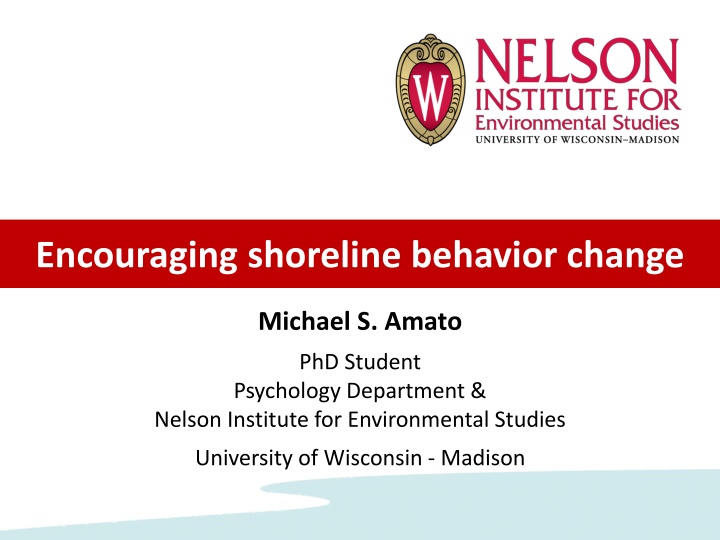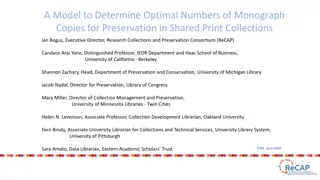
Encouraging Shoreline Behavior Change: Insights from Beliefs and Goals Studies
Discover how beliefs and goals impact shoreline grooming behaviors through studies conducted by Michael S. Amato, a PhD student at the University of Wisconsin-Madison. Explore the significance of rights of nature, fragility of nature, aesthetic preferences, and usability for recreation in influencing decisions about shoreline maintenance. Gain insights into effective communication strategies to encourage positive shoreline behavior change.
Download Presentation

Please find below an Image/Link to download the presentation.
The content on the website is provided AS IS for your information and personal use only. It may not be sold, licensed, or shared on other websites without obtaining consent from the author. If you encounter any issues during the download, it is possible that the publisher has removed the file from their server.
You are allowed to download the files provided on this website for personal or commercial use, subject to the condition that they are used lawfully. All files are the property of their respective owners.
The content on the website is provided AS IS for your information and personal use only. It may not be sold, licensed, or shared on other websites without obtaining consent from the author.
E N D
Presentation Transcript
Encouraging shoreline behavior change Michael S. Amato PhD Student Psychology Department & Nelson Institute for Environmental Studies University of Wisconsin - Madison
Study 1: Beliefs & Goals How do people make decisions about their shore? How are people who engage in restoration different from people who don t? Encouraging shoreline behavior change
Study 1: Beliefs & Goals How do people make decisions about their shore? How are people who engage in restoration different from people who don t? Many possible reasons for different choices: Emphasis on common good vs. self-interest Belief in rights of nature versus humans Belief in fragility of nature Goals for their property
Beliefs and Goals for Shoreline Decisions Study method: Survey sent to Burnett Co. owners (n = 155 ; 64% resp rate) Questions about beliefs, goals, etc. Questions about grooming behaviors: Shower Shave Cut trees and shrubs Mow Rake Maintain beach
Beliefs and Goals for Shoreline Decisions Results Beliefs associated with LESS shoreline grooming: Rights of nature ( = -0.34, 99% CI = [-0.61, -0.07]) Fragility of nature ( = -0.25, 99% CI = [0.09, 0.41]) Implications for communication: Emphasize empathy with animals; personification Emphasize delicate balance of lake ecosystem
Beliefs and Goals for Shoreline Decisions Results Goals associated with MORE shoreline grooming: Importance of pleasing aesthetic ( = 0.34, 99% CI = [0.11, 0.57]) Importance of usability for recreation ( = 0.36, 99% CI = [0.14, 0.58]) Implication for communication: Offer solutions compatible with those two goals
Beliefs and Goals for Shoreline Decisions One final point on this: BELIEFS(rights + fragility) affected behavior by affecting perceived importance of shore vegetation GOALS (aesthetic + usability) affected behavior independently of perceived importance of shore vegetation
Study 1: Beliefs & Goals for Shoreline Decisions How do people make decisions about their shore? How are people who engage in restoration different from people who don t? Encouraging shoreline behavior change Study 2: The Barrier of Self-Perception Bias What are the barriers that prevent people from improving their shore?
The Barrier of Self-Perception Bias come to view old behavior as undesirable new behavior: grow vegetated shoreline old behavior: maintain groomed shoreline
The Barrier of Self-Perception Bias come to view old behavior as undesirable 1. Humans are not objective observers of the world. 2. We perceive the world in ways that promote a positive self-view. old behavior new behavior 3.Current shoreline state reflects pastdecisions. 4.Owners are motivated to avoid negative conclusions about their past decisions.
The Barrier of Self-Perception Bias Study method: Central Wisconsin 71 property owners (59% response rate) Rated photos of shorelines on 4 measures: natural beauty, water quality, habitat, usability 8 photos: 1 photo of their own shoreline +7 photos of other participants shorelines
The Barrier of Self-Perception Bias Study method: Central Wisconsin 71 property owners (59% response rate) Rated photos of shorelines on 4 measures: natural beauty, water quality, habitat, usability 8 photos: 1 photo of their own shoreline +7 photos of other participants shorelines
The Barrier of Self-Perception Bias Study result: Owners underestimate their own shoreline s impact rated by other rated by owner 7 high 6 5 4 3 2 low 1 Natural Beauty Usefulness Water Quality Habitat Provided
The Barrier of Self-Perception Bias rated by other rated by owner Natural Beauty Usefulness Water Quality Habitat Provided Implications: Owners are unlikely to improve their shoreline if they don t perceive a problem. Owners who think lake health is important are especially prone to self-perception bias.
Future Research Beliefs & Goals Evaluate actual behavior (not self-report) Use survey responses to tailor messages Self-Perception Bias Test methods for delivering objective feedback Self-assessment worksheet Lake Health Report
Michael Amato Bret Shaw John Haack Thank you for your time! Thank you to Wisconsin Department of Natural Resources
Category Construct Item Text self-transcendence Wisconsin's lakes should be available to everyone. self-enhancement I am proud to own property on a lake. values stimulation I find it personally satisfying to spend time at the lake. security Owning lake property gives me a feeling of security. nature s resilience The lake can withstand human modifications of the shoreline. The health of the lakes is dependent on human intervention and ingenuity. It is important to protect the lake for the plants and animals that live there. biospheric beliefs human ingenuity rights of nature affective enjoy My ability to enjoy my property affective aesthetic How much I will like the look of it gain cost Cost of the different options goals gain resale Resale value of my property normative fit How the look of my shoreline fits in with others nearby normative health Effects on the overall health of the lake It is important that I let my shoreline grow in a natural, vegetated state. mediator importance

